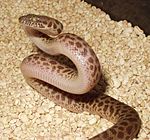Antaresia
| Antaresia | |
|---|---|

| |
| Stimson's python, A. stimsoni | |
| Scientific classification | |
| Domain: | Eukaryota |
| Kingdom: | Animalia |
| Phylum: | Chordata |
| Class: | Reptilia |
| Order: | Squamata |
| Suborder: | Serpentes |
| Family: | Pythonidae |
| Subfamily: | Pythoninae |
| Genus: | Antaresia Wells & Wellington, 1984 |
| Species | |
|
See text | |
| Synonyms | |
| |
Antaresia is a genus of pythons, nonvenomous snakes found in Australia. The genus is known by the common name Children's pythons, the name of the type species. Gray named it in honour of his mentor, John George Children, who was a curator of the zoological collection at the British Museum around that time. It contains the smallest members of the Pythonidae.[2] Currently, four species are recognized, although they were all considered part of the same species until recently.[3]
Geographic range
The species are found in Australia in arid and tropical regions.[1]
Species
| Species[4] | Taxon author[4] | Common name | Geographic range[1] |
|---|---|---|---|
| A. childreniT | (Gray, 1842) | Children's python | Australia in the extreme north of Western Australia, the northern third of Northern Territory, and northeastern Queensland, and on the islands of the Torres Strait |
| A. maculosa | (Peters, 1873) | Spotted python | Australia from the extreme north of the Cape York Peninsula, south through eastern Queensland to northern New South Wales, and on many islands off the coast of Queensland |
| A. perthensis | (Stull, 1932) | Pygmy python | Australia in the northwest of Western Australia, including some coastal islands |
| A. stimsoni | (L.A. Smith, 1985) | Stimson's python | Australia from the coast of Western Australia through the center of the country as far as the Great Dividing Range, not found in the far north, extreme south, or east |
*) Not including the nominate subspecies.
T) Type species.[1]
Taxonomy
The name is taken from the star Antares in the constellation Scorpius. The genus name was created in 1984 by Wells and Wellington in a revision of Children's pythons, those previously described as a single species in the genus Liasis. Despite a petition to suppress the taxonomic work of these authors, it gained wide acceptance and publication in 1991.
Four species are currently recognized in the genus Antaresia, which is contained by the family Pythonidae; infraspecific ranks have also been described.[4]
A subspecies, A. stimsoni orientalis was described by L.A. Smith (1985), but was not recognized as valid by Barker & Barker (1994).[1]
References
- ^ a b c d e McDiarmid RW, Campbell JA, Touré T. 1999. Snake Species of the World: A Taxonomic and Geographic Reference, vol. 1. Herpetologists' League. 511 pp. ISBN 1-893777-00-6 (series). ISBN 1-893777-01-4 (volume).
- ^ Browne-Cooper, Robert; Brian Bush; Brad Maryan; David Robinson (2007). Reptiles and Frogs in the Bush: Southwestern Australia. University of Western Australia Press. p. 99. ISBN 978-1-920694-74-6.
- ^ "Spotted Python". Reptile Range. Retrieved 2 April 2020.
- ^ a b c "Antaresia". Integrated Taxonomic Information System. Retrieved 9 September 2007.
External links
- Antaresia.com. Four antaresia subspecies information.
- Antaresia at the Reptarium.cz Reptile Database. Accessed 9 September 2007.
- Antaresia.info. Accessed 13 November 2007.




